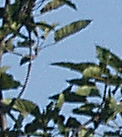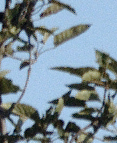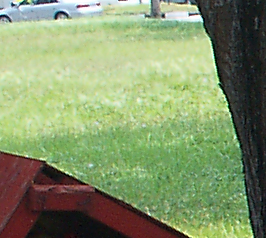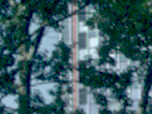Camedia Master vs DCRAW
The Camedia Master software for Olympus digital cameras does a very good job on handling
raw images. Although I'm not a photograph expert I think it gives
Nice colors, sharp, and a useful range of the sliders to get the tone, sharpness and lighting
spot on. It is sometimes annoyingly slow, but DCRAW isn't any faster.
But sometimes there are minor problems with Camedia Master. The free available
DCRAW
program offers an interesting alternative for the Camedia software. Dave Coffin even provides the source
code, which gives the only opportunity I know of to learn the inside of RAW processing. Thanks Dave!
Here, I compare their strengths and weaknesses in a few problem images.
Although the effects discussed below look pretty bad, remember that these are
all quite worse-case effects, and that they are enlarged extremely to make them good visible.
In all cases, they are hardly if at all visible in normal viewing sizes.
Note: I saved all the images in highest-quality JPG format.
However very minor artefacts might be introduced because of that.
The comparisons were all done with using TIF and RAW formats.
As you can see in the figures below, the Camedia Master software
sometimes introduces annoying halos around high-contrast edges,
for instance leaves against the blue sky. This is not blue fringing,
as is proven by the same image processed by the DCRAW program.
It looks more like some sharpening algorithm.
On the other hand, the dcraw image has quite some noise. Again, this isn't visible
at normal zoom levels. I think it's less visible than the halos, and leaves a bit more
detail in the image. Halos can also appear in photoshop if the
contrast would be extremely enhanced, but they stay less obvious there and you
have better control over this in photoshop.
My preference goes to DCRAW here.


| Halos around the leaves in Camedia Master. Maximum sharpness, other settings default. | No halos in DCRAW/Photoshop 7. 280% unsharp mask, 0.3 pixels; auto white correction. |
As could already be seen in the previous image, the sky gets a bit plastic look,
because all noise is removed.
It seems some noise reduction algorithm inside Camedia Master, similar
to Photoshop's "smart blur".
I did NOT turn on noise reduction in Camedia Master, and none of the sliders could remove this effect.
For skies this is not a serious problem.
But when the same effect appears on other things that are known not
to be smooth, such as skin, grass or clothing, I find this effect annoying or
even sometimes highly disturbing.
The DCRAW has a bit noise, but much less visible than in the previous picture.
I prefer this over plastification, and also over the few but a bit more harsh noise pixels
in the Camedia Master image.
It also depends on the situation: in the pictures below I expect
other things such as hairs to be just barely visible, so some noise can be explained
by that. But when the skin is a bit smaller (same arm but less pixels),
smoothing would be the better option.


| "Plastified" Arm and white woven fabric, Camedia Master, all settings default. | no plastification in DCRAW. No processing, . |


| "Plastified" grass at distance, Camedia Master, +0.2 stops exposure correction, sharpness +2, saturation +1, contrast -5, sunny white preset. | no plastification in DCRAW. Color, contrast, brightness corrections applied, unsharp mask 310% r=0.5. |
But it's not all perfect with DCRAW.
In the picture below you see some strange
artefact I ran into, when I zoomed in on a building hidden between the branches of a tree.
The building is lit brightly and has large color contrasts, causing very sharp edges in the image.
There is a raveling effect in the vertical beams of the building. With additional
sharpening and contrast enhancements, this effect gets only worse and also appears in
the red bar.
In fact this artefact is visible also in photos of other people using DCRAW,
see the links at the bottom of this page.
I don't fully understand this artefact, the variable-number of gradients interpolation algorithm used in dcraw
(see Ting Chen's course on
Interpolation Algorithms for Single-Detector Digital Cameras) is supposed to avoid such raveling.
Is there a bug in the software? do we reach the limits of the algorithm? Some parameter set
at an unfortunate level?


| Building between the trees, looking nice and sharp. Fully sharpened and high contrast. | Raveling in DCRAW. Slightly enhanced colors, but still without sharpening and contrast. |
I overcome the problems I tried to get better results by doing a full conversion of a picture by hand
from the raw image.
This is quite some and quite complex work, but using standard scaling, colorspace conversions and channel mixing in photoshop.
Maybe I will write another page describing all the steps involved in the handwork....
With handwork I think you can indeed get a better image.
The images below show an impression, This looks slightly more detailed than dcraw,
AND without the artefacts of dcraw.
Additionally, you get full control over the noise reduction, for instance you could do
localized smart blurring only in areas where that is appropriate.
I'm not sure where you would end up
after sharpening and boosting the colors, I still have a hard time getting the colors
spot on in these hand-made raw conversions.


| Same picture, now converted fully by hand. | More handwork (more detailed luminance image) giving me yet more detail. |
The Camedia Master software in most cases gives good images, sharp and good colors.
But in some cases this software gives some artefacts that
might be avoidable if we could turn off noise reduction.
The dcraw converter might be usable to avoid these artefacts.
However there are some other artefacts being introduced by dcraw.
Furthermore, I have no good color profile, and a lot of tweaking is needed to get the colors
acceptable with dcraw, while the Camedia Master software gives convincing colors and very good
colors with some tweaking. I definitely need to get such a color profile before
further comparisons can be done.
You can find another comparisons of DCRAW on the website of Timo Autiokari and Francisco Montilla.